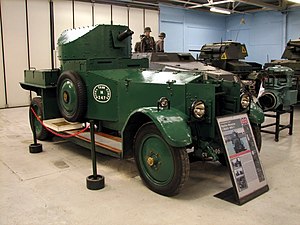| Rolls Royce armoured car | |
|---|---|
 Rolls Royce 1920 Pattern Mk1 armoured car at The Tank Museum, Bovington | |
| Type | Armoured car |
| Place of origin | United Kingdom |
| Service history | |
| In service | 1915–1944 |
| Wars | |
| Production history | |
| Manufacturer | Rolls-Royce |
| No. built | 120 (First World War) |
| Variants | Rolls-Royce 1920 Pattern, Rolls-Royce 1924 Pattern, Fordson armoured car, Rolls Royce Indian Pattern[1] |
| Specifications | |
| Mass | 4.7 tonnes[1] |
| Length | 4.93 m (194 in)[1] |
| Width | 1.93 m (76 in)[1] |
| Height | 2.54 m (100 in)[1] |
| Crew | 3 (commander, driver, and machine-gunner)[1] |
| Armor | 12 mm (0.47 in) |
Main armament | .303 (7.7 mm) Vickers machine gun[1] |
Secondary armament | none |
| Engine | 6-cylinder petrol, water-cooled [1] 80 hp (60 kW)[1] |
| Power/weight | 19 hp/tonne |
| Suspension | 4x2 wheel (double rear wheels), leaf spring[1] |
Operational range | 240 km or 150 miles[1] |
| Maximum speed | 72 km/h (45 mph)[1] |
The Rolls-Royce armoured car is a British armoured car developed in 1914 and used during the First World War, Irish Civil War, the inter-war period in Imperial Air Control in Transjordan, Palestine and Mesopotamia, and in the early stages of the Second World War in the Middle East and North Africa.